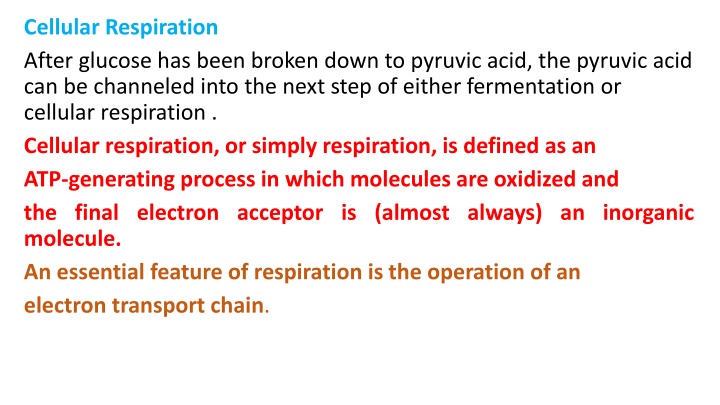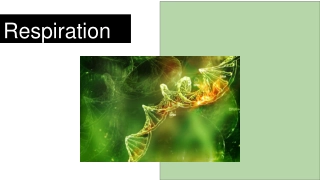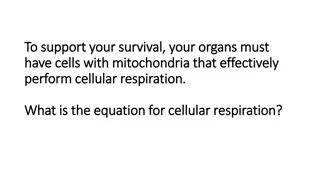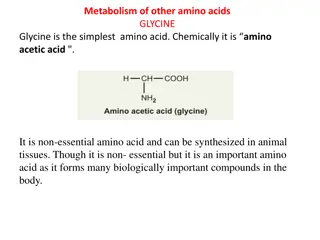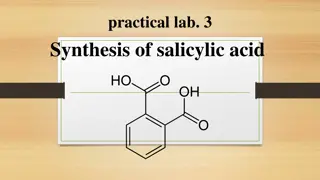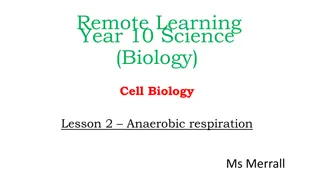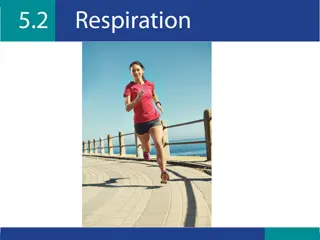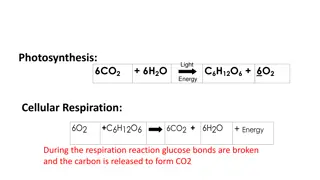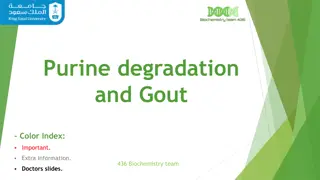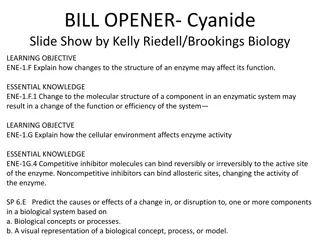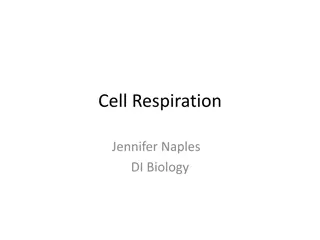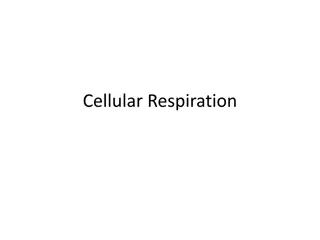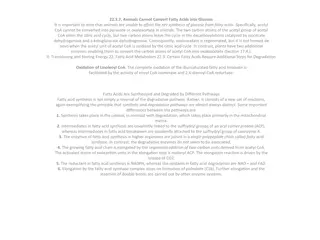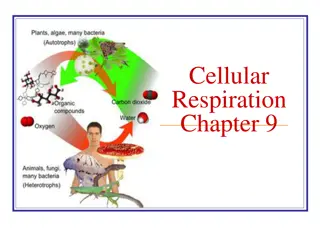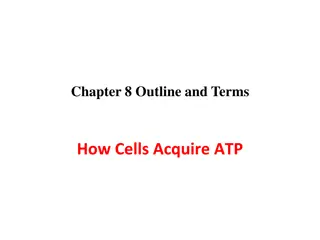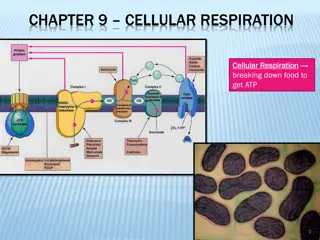Cellular Respiration: Pyruvic Acid Pathway Options
After glucose is converted to pyruvic acid, it can enter either fermentation or cellular respiration. This decision directs the fate of the pyruvic acid and plays a crucial role in energy production within cells. Understanding the pathways and processes involved is essential for comprehending how organisms harness energy from glucose effectively. The choice between fermentation and cellular respiration has significant implications for cellular energy generation and metabolic efficiency.
Download Presentation

Please find below an Image/Link to download the presentation.
The content on the website is provided AS IS for your information and personal use only. It may not be sold, licensed, or shared on other websites without obtaining consent from the author.If you encounter any issues during the download, it is possible that the publisher has removed the file from their server.
You are allowed to download the files provided on this website for personal or commercial use, subject to the condition that they are used lawfully. All files are the property of their respective owners.
The content on the website is provided AS IS for your information and personal use only. It may not be sold, licensed, or shared on other websites without obtaining consent from the author.
E N D
Presentation Transcript
Cellular Respiration After glucose has been broken down to pyruvic acid, the pyruvic acid can be channeled into the next step of either fermentation or cellular respiration . Cellular respiration, or simply respiration, is defined as an ATP-generating process in which molecules are oxidized and the final electron acceptor is (almost always) an inorganic molecule. An essential feature of respiration is the operation of an electron transport chain.
There are two types of respiration, depending on whether an organism is an aerobe, which uses oxygen, or an anaerobe, which does not use oxygen and may even be killed by it. In aerobic respiration, the final electron acceptor is O2; in anaerobic respiration, the final electron acceptor is an inorganic molecule other than O2 or, rarely, an organic molecule.
Aerobic Respiration The Krebs Cycle : The Krebs cycle, also called the tricarboxylic acid (TCA) cycle or citric acid cycle, is a series of biochemical reactions in which the large amount of potential chemical energy stored in acetyl CoA is released step by step . In this cycle, a series of oxidations and reductions transfer that potential energy, in the form of electrons, to electron carrier coenzymes, chiefly NAD+. The pyruvic acid derivatives are oxidized; the coenzymes are reduced.
Pyruvic acid, the product of glycolysis, cannot enter the Krebs cycle directly. In a preparatory step, it must lose one molecule of CO2 and become a two-carbon compound . This process is called decarboxylation. The two-carbon compound, called an acetyl group, attaches to coenzyme A through a high-energy bond; the resulting complex is known as acetyl coenzyme A (acetyl CoA). During this reaction, pyruvic acid is also oxidized, and NAD+ is reduced to NADH.
Remember that the oxidation of one glucose molecule produces two molecules of pyruvic acid, so for each molecule of glucose, two molecules of CO2 are released in this preparatory step, two molecules of NADH are produced, and two molecules of acetyl CoA are formed. Once the pyruvic acid has undergone decarboxylation and its derivative (the acetyl group) has attached to CoA, the resulting acetyl CoA is ready to enter the Krebs cycle.
As acetyl CoA enters the Krebs cycle, CoA detaches from the acetyl group. The two-carbon acetyl group combines with a four carbon compound called oxaloacetic acid to form the six-carbon citric acid. This synthesis reaction requires energy, which is provided by the cleavage of the high-energy bond between the acetyl group and CoA. The formation of citric acid is thus the first step in the Krebs cycle.
The chemical reactions of the Krebs cycle fall into several general categories; one of these is decarboxylation. For example, in Step 3 isocitric acid a six -carbon compound, is decarboxylated to the five-carbon compound called -ketoglutaric acid. Another decarboxylation takes place in stape 4. Because one carboxylic cycle has taken place in the preparatory step and two in the Krebs cycle, all three carbon atoms in pyruvic acid are eventually released as CO2 by the Krebs cycle. This represents the conversion to CO2 of all six carbon atoms contained in the original glucose molecule.
If we look at the Krebs cycle as a whole, we see that for every two molecules of acetyl CoA that enter the cycle, four molecules of CO2 are liberated by decarboxylation, six molecules of NADH and two molecules of FADH2 are produced by oxidation-reduction reactions,and two molecules of ATP are generated by substrate- level phosphorylation. A molecule of guanosine triphosphate (GTP), formed from guanosine diphosphate (GDP + P smallest size, for in text. i), is similar to ATP and serves as an intermediary at this point in the cycle. Many of the intermediates in the Krebs cycle also play a role in other pathways, especially in amino acid biosynthesis
The CO2 produced in the Krebs cycle is ultimately liberated into the atmosphere as a gaseous by-product of aerobic respiration. The reduced coenzymes NADH and FADH2 are the most important products of the Krebs cycle because they contain most of the energy originally stored in glucose. During the next phase of respiration, a series of reductions indirectly transfers the energy stored in those coenzymes to ATP. These reactions are collectively called the electron transport chain
The Electron Transport Chain (System) An electron transport chain (system) consists of a sequence of carrier molecules that are capable of oxidation and reduction. As electrons are passed through the chain, there occurs a stepwise release of energy, which is used to drive the chemiosmotic generation of ATP,. The final oxidation is irreversible. In eukaryotic cells, the electron transport chain is contained in the inner membrane of mitochondria; in prokaryotic cells, it is found in the plasma membrane.
There are three classes of carrier molecules in electron transport chains. The first are flavoproteins. These proteins contain flavin, a coenzyme derived from riboflavin (vitamin B2), and are capable of performing alternating oxidations and reductions. One important flavin coenzyme is flavin mononucleotide (FMN). The second class of carrier molecules are cytochromes, proteins with an iron-containing group (heme) capable of existing alternately as a reduced form (Fe2+) and an oxidized form (Fe3+).
The cytochromes involved in electron transport chains include cytochrome b (cyt b), cytochrome c1 (cyt c1), cytochrome c (cyt c), cytochrome a (cyt a), and cytochrome a3 (cyt a3). The third class is known as ubiquinones, or coenzyme Q, symbolized Q; these are small nonprotein carriers. The electron transport chains of bacteria are somewhat diverse, in that the particular carriers used by a bacterium and the order in which they function may differ from those of other bacteria and from those of eukaryotic mitochondrial systems. Even a single bacterium may have several types of electron transport chains.
However, keep in mind that all electron transport chains achieve the same basic goal: to release energy as electrons are transferred from higher-energy compounds to lower-energy compounds. Much is known about the electron transport chain in the mitochondria of eukaryotic cells, so this is the chain we will describe. The first step in the mitochondrial electron transport chain involves the transfer of high-energy electrons from NADH to FMN, the first carrier in the chain . This transfer actually involves the passage of a hydrogen atom with two electrons to FMN, which then picks up an additional H+ from the surrounding aqueous medium.
The next part of the electron transport chain involves the cytochromes. Electrons are passed successively from Q to cyt b, cyt c1, cyt c, cyt a, and cyt a3. Each cytochrome in the chain is reduced as it picks up electrons and is oxidized as it gives up electrons. The last cytochrome, cyt a3, passes its electrons to molecular oxygen (O2), which becomes negatively charged and then picks up protons from the surrounding medium to form H2O.
Notice that FADH2, which is derived from the Krebs cycle, as another source of electrons. However, FADH2 adds its electrons to the electron transport chain at a lower level than NADH. Because of this, the electron transport chain produces about one-third less energy for ATP generation when FADH2 donates electrons than when NADH is involved. An important feature of the electron transport chain is the presence of some carriers, such as FMN and Q, that accept and release protons as well as electrons, and other carriers, such as cytochromes, that transfer electrons only.
Electron flow down the chain is accompanied at several points by the active transport (pumping) of protons from the matrix side of the inner mitochondrial membrane to the opposite side of the membrane. The result is a buildup of protons on one side of the membrane. Just as water behind a dam stores energy that can be used to generate electricity, this buildup of protons provides energy for the generation of ATP by the chemiosmotic mechanism.
The Chemiosmotic Mechanism of ATP Generation The mechanism of ATP synthesis using the electron transport chain is called chemiosmosis. Recall that substances diffuse passively across membranes from areas of high concentration to areas of low concentration; this diffusion yields energy. Recall also that the movement of substances against such a concentration gradient requires energy and that, in such an active transport of molecules or ions across biological membranes, the required energy is usually provided by ATP.
In chemiosmosis, the energy released when a substance moves along a gradient is used to synthesize ATP. The substance in this case refers to protons. In respiration, chemiosmosis is responsible for most of the ATP that is generated. The steps of chemiosmosis are as follows
Anaerobic Respiration In anaerobic respiration, the final electron acceptor is an inorganic substance other than oxygen (O2). Some bacteria, such as Pseudomonas and Bacillus, can use a nitrate ion (NO3 ) as a final electron acceptor; the nitrate ion is reduced to a nitrite ion (NO2 ), nitrous oxide (N2O), or nitrogen gas (N2). Other bacteria, such as Desulfovibrio use sulfate (SO4 2 ) as the final electron acceptor to form hydrogen sulfide (H2S). Still other bacteria use carbonate (CO3 2 ) to form methane (CH4).
Anaerobic respiration by bacteria using nitrate and sulfate as final acceptors is essential for the nitrogen and sulfur cycles that occur in nature. The amount of ATP generated in anaerobic respiration varies with the organism and the pathway. Because only part of the Krebs cycle operates under anaerobic conditions, and because not all the carriers in the electron transport chain participate in anaerobic respiration, the ATP yield is never as high as in aerobic respiration. Accordingly, anaerobes tend to grow more slowly than aerobes.
Fermentation After glucose has been broken down into pyruvic acid, the pyruvic acid can be completely broken down in respiration, or it can be converted to an organic product in fermentation, whereupon NAD+ and NADP+ are regenerated and can enter another round of glycolysis . Fermentation can be defined in several ways but we define it here as a process that 1.releases energy from sugars or other organic molecules, such as amino acids, organic acids, purines, and pyrimidines; 2. does not require oxygen (but sometimes can occur in its presence); 3. does not require the use of the Krebs cycle or an electron transport chain
4. uses an organic molecule as the final electron acceptor; 5. produces only small amounts of ATP (only one or two ATP molecules for each molecule of starting material) because much of the original energy in glucose remains in the chemical bonds of the organic end-products, such as lactic acid or ethanol. During fermentation, electrons are transferred (along with protons) from reduced coenzymes (NADH, NADPH) to pyruvic acid or its derivatives .Those final electron acceptors are reduced to the end- products .An essential function of the second stage of fermentation is to ensure a steady supply of NAD+ and NADP+ so that glycolysis can continue
In fermentation, ATP is generated only during glycolysis. Microorganisms can ferment various substrates; the end products depend on the particular microorganism, the substrate, and the enzymes that are p resent and active. Chemical analyses of these end-products are useful in identifying microorganisms. the more important processes: lactic acid fermentation and alcohol fermentation.
Lactic Acid Fermentation During glycolysis, which is the first phase of lactic acid fermentation, a molecule of glucose is oxidized to two molecules of pyruvic acid . This oxidation generates the energy that is used to form the two molecules of ATP. In the next step, the two molecules of pyruvic acid are reduced by two molecules of NADH to form two molecules of lactic acid .Because lactic acid is the end-product of the reaction, it undergoes no further oxidation, and most of the energy produced by the reaction remains stored in the lactic acid. Thus, this fermentation yields only a small amount of energy.
Two important genera of lactic acid bacteria are Streptococcus and Lactobacillus .Because these microbes produce only lactic acid, they are referred to as homolactic (or homofermentative). Lactic acid fermentation can result in food spoilage. However, the process can also produce yogurt from milk, and pickles from cucumbers.
Alcohol Fermentation Alcohol fermentation also begins with the glycolysis of a molecule of glucose to yield two molecules of pyruvic acid and two molecules of ATP. In the next reaction, the two molecules of pyruvic acid are converted to two molecules of acetaldehyde and two molecules of CO2 . The two molecules of acetaldehyde are next reduced by two molecules of NADH to form two molecules of ethanol. Again, alcohol fermentation is a low energy- yield process because most of the energy contained in the initial glucose molecule remains in the ethanol, the end-product.
Alcohol fermentation is carried out by a number of bacteria and yeasts. The ethanol and carbon dioxide produced by the yeast Saccharomyces are waste products for yeast cells but are useful to humans. Ethanol made by yeasts is the alcohol in alcoholic beverages, and carbon dioxide made by yeasts causes bread dough to rise. Organisms that produce lactic acid as well as other acids or alcohols are known as heterolactic (or heterofermentative) and often use the pentose phosphate pathway
Photosynthesis In all of the metabolic pathways ,organisms obtain energy for cellular work by oxidizing organic compounds. But where do organisms obtain these organic compounds? Some, including animals and many microbes, feed on matter produced by other organisms. For example, bacteria may catabolize compounds from dead plants and animals, or they may obtain nourishment from a living host.
Other organisms synthesize complex organic compounds from simple inorganic substances. The major mechanism for such synthesis is a process called photosynthesis, which is carried out by plants and many microbes. Essentially, photosynthesis is the conversion of light energy from the sun into chemical energy. The chemical energy is then used to convert CO2 from the atmosphere to more reduced carbon compounds, primarily sugars. The word photosynthesis summarizes the process: photo means light, and synthesis refers to the assembly of organic compounds. This synthesis of sugars by using carbon atoms from CO2 gas is also called carbon fixation.
Continuation of life as we know it on Earth depends on the recycling of carbon in this way . Cyanobacteria, algae, and green plants all contribute tothis vital recycling with photosynthesis.
